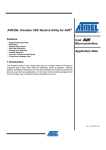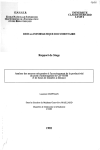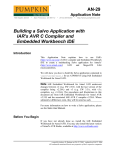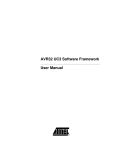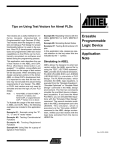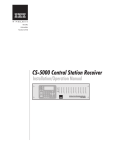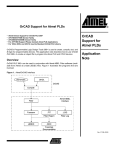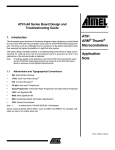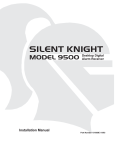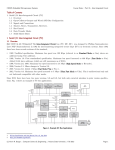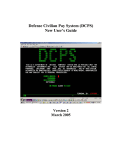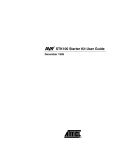Download AVR350: XmodemCRC Receive Utility for AVR(R)
Transcript
AVR350: XmodemCRC Receive Utility for AVR®
8-bit
Microcontroller
Features
•
•
•
•
•
•
•
•
Programmable Baud Rate
Half Duplex
128-byte Data Packets
CRC Data Verification
Framing Error Detection
OverRun Detection
Less than 1K Bytes of Code Space
C High-level Language Code
Application
Note
Introduction
The Xmodem protocol was created years ago as a simple means of having two computers talk to each other. With its half-duplex mode of operation, 128-byte packets,
ACK/NACK responses and CRC data checking, the Xmodem protocol has found its
way into many applications. In fact most communication packages found on the PC
today have a Xmodem protocol available to the user.
Theory of Operation
Xmodem is a half-duplex communication protocol. The Receiver, after receiving a
packet, will either acknowledge (ACK) or not acknowledge (NACK) the packet. The
original Xmodem protocol used a standard checksum method to verify the 128-byte
data packet. The CRC extension to the original protocol uses a more robust 16-bit
CRC to validate the data block and is used here. Xmodem can be considered to be
receiver driven. That is, the Receiver sends an initial character “C” to the sender indicating that it’s ready to receive data in CRC mode. The Sender then sends a 133-byte
packet, the Receiver validates it and responds with an ACK or a NACK at which time
the sender will either send the next packet or re-send the last packet. This process is
continued until an EOT is received at the Receiver side and is properly ACKed to the
Sender. After the initial handshake the receiver controls the flow of data through ACKing and NAKing the Sender.
Table 1. XmodemCRC Packet Format
Byte 1
Byte 2
Byte 3
Bytes 4 - 131
Bytes 132 - 133
Start of Header
Packet Number
∼(Packet Number)
Packet Data
16-bit CRC
Rev. 1472B–AVR–05/02
1
Definitions
The following defines are used for protocol flow control.
Table 2. Protocol Flow Control
Symbol
Description
Value
SOH
Start of Header
0x01
EOT
End of Transmission
0x04
ACK
Acknowledge
0x06
NAK
Not Acknowledge
0x15
C
ASCII “C”
0x43
Byte one of the XmodemCRC packet can only have a value of SOH or EOT, anything
else is an error. Bytes two and three form a packet number with checksum, add the two
bytes together and they should always equal 0xff. Please note that the packet number
starts out at “1” and rolls over to “0” if there are more than 255 packets to be received.
Bytes 4 - 131 form the data packet and can be anything. Bytes 132 and 133 form the 16bit CRC. The high byte of the CRC is located in byte 132.
Synchronization
The Receiver starts by sending an ASCII “C” (0x43) character to the sender indicating it
wishes to use the CRC method of block validating. After sending the initial “C” the
receiver waits for either a three second time out or until a buffer full flag is set. If the
receiver is timed out then another “C” is sent to the sender and the three second time
out starts again. This process continues until the receiver receives a complete 133-byte
packet.
Receiver
Considerations
This protocol NACKs the following conditions:
1. Framing error on any byte
2. OverRun error on any byte
3. Duplicate packet
4. CRC error
5. Receiver timed out (didn't receive packet within one second)
On any NAK, the sender will re-transmit the last packet. Items one and two should be
considered serious hardware failures. Verify that sender and receiver are using the
samebaud rate, start bits and stop bits. Item three is usually the sender getting an ACK
garbled and re-transmitting the packet. Item four is found in noisy environments. And the
last issue should be self-correcting after the receiver NAKs the sender.
2
AVR350
1472B–AVR–05/02
AVR350
Data Flow Diagram
The data flow diagram below simulates a 5-packet file being sent.
Table 3. XmodemCRC Data Flow with Errors
Sender
Receiver
<----
“C”
Times Out after Three Seconds
SOH
SOH
SOH
SOH
<----
“C”
---->
Packet OK
<----
ACK
---->
(Line Hit during Data Transmission)
<----
NACK
---->
Packet OK
<----
ACK
---->
Packet OK
<----
ACK
---->
Duplicate Packet
<----
NACK
---->
(UART Framing Error on Any Byte)
<----
NACK
---->
Packet OK
<----
ACK
---->
(UART Overrun Error on Any Byte)
<----
NACK
---->
Packet OK
<----
ACK
EOT
---->
Packet OK
(ACK Gets Garbled)
<----
ACK
EOT
---->
Packet OK
Finished
<----
ACK
0x01
0x02
0x02
0x03
0xFE
0xFD
0xFD
0xFC
Data
Data
Data
Data
CRC
CRC
CRC
CRC
(ACK Gets Garbled)
SOH
SOH
SOH
SOH
SOH
0x03
0x04
0x04
0x05
0x05
0xFC
0xFB
0xFB
0xFA
0xFA
Data
Data
Data
Data
Data
CRC
CRC
CRC
CRC
CRC
3
1472B–AVR–05/02
Modifications to
Receive Protocol
Users may wish to count how many “C’s” were sent during synchronization and after “n”
number of tries abort the receive attempt.
For embedded applications it’s not mandatory to have a 128-byte packet. You could
have 64, 32, or even a 16-byte packet. The sender of course would have to comprehend
this. For users that may want to migrate to Atmel's MegaAVR series there is a version of
Xmodem that uses a 1Kbyte packet. Or you can use an external SRAM with an
AT90S4414 or an AT90S8515 to allow the increase in packet size.
If users do not wish to use the CRC method of data verification, simply replace sending
a “C” for synchronization with a NAK instead. The sender will then send only the simple
checksum of the data packet. Of course, the buffer size decreases by one and data
errors may occur. This modification would allow communication with equipment that
supports only the checksum method of data verification.
Software
Routines were compiled using IAR’s “C” compiler version 1.40 with max size optimization. The software was te sted using ProComm, DynaComm, Win Comm, a nd
Hyperterminal at baud rates up to 115.2K bps. The receiver expects 8 start bits, 1 stop
bit, and no parity bits.
The STK200 starter kit is used as a test platform with minor, optional, modifications. A
baud rate friendly crystal was used for this code. Replace the 4.0 MHz crystal on the
STK200 starter kit with a 7.3728 MHz crystal for proper operation. If users wish to use
the default crystal then modify the init routine to properly set up the uart baud rate register UBRR. Wait loops in the sendc and the recv_wait routines would also need
modification.
To verify proper operation of this code, the PORT D bit 2 should be connected to the
switches on the starter kit. Refer to the STK200 user manual for jumper locations and
definitions. Connect a 9-pin serial cable from a PC to the starter kit, turn on power and
use pushbutton two as a start of reception signal. Use an ICEPRO Emulator, an
AT90S4414-8PC, or an AT90S8515-8PC to execute the code.
Table 4. Routines
4
Name
Size in Bytes
Function
calcrc
60
Calculates 16-bit CRC
init
30
Low-level Hardware Initialization
main
280
Main
purge
36
Reads UART Data Register for One Second
receive
64
Main Receive Routine
recv_wait
40
Waits until Buffer Full Flag is Set or One Second Timeout
respond
44
Sends an ACK or a NACK to the Sender
sendc
88
Sends an ASCII “C” Character to the Sender until the
Buffer Full Flag is Set
timer1
28
Timer1 Interrupt
uart
80
Uart Receive Interrupt
validate_packet
155
Validates Senders Packet
AVR350
1472B–AVR–05/02
AVR350
Pseudo-Code
purge.c
initialize timer1 counter for a 1 second delay read uart for 1 second
receive.c
send a 'C' character to sender until receive buffer is full validate received packet send an ack or a nak to
sender
if packet was bad then wait for new
good packet
while not end of transmission
wait for buffer to fill
validate the packet
send an ack or a nak to sender
recv_wait.c
initialize timer1 counter for a 1 second delay wait till buffer is full or timeout
respond.c
clear error flags
if packet was good a duplicate packet or end of transmission then
send an ack
else
purge senders uart transmit buffer
send a nack
sendc.c
initialize timer1 counter for a 3 second delay
clear error flags
while buffer is not full
send 'C' character to sender, signaling CRC mode
enable timer counter
wait for buffer full or timeout
if timed out clear error flags
restart timer
uart.c
check uart for framing or overrun errors
read byte from uart
verify first byte in receive buffer is valid
if buffer is full set buffer full flag
5
1472B–AVR–05/02
validate_packet.c
if not timed out then
if no uart framing or overrun errors then
if first character in buffer is SOH then
if second character in buffer is the next packet number
then
if second character in buffer plus the third character in buffer = 0xff
then
compute CRC on packet data
if CRC ok
then
increment packet number
packet = good
else
packet = bad
else
bad packet number checksum
else
duplicate packet number
else
if first character in buffer is EOT then
end of transmission
else
at least 1 byte had a framing or overrun error, packet is bad
else
timed-out without receiving all characters, packet is bad
6
AVR350
1472B–AVR–05/02
AVR350
Code Listing
Calcrc.c
#include "xmodem.h"
int calcrc(char *ptr, int count)
{
int crc;
char i;
crc = 0;
while (--count >= 0)
{
crc = crc ^ (int) *ptr++ << 8;
i = 8;
do
{
if (crc & 0x8000)
crc = crc << 1 ^ 0x1021;
else
crc = crc << 1;
} while(--i);
}
return (crc);
}
Init.c
#include "xmodem.h"
void init(void)
{
// portd bit 2 used to start data reception
// Pb7, Pb6, Pb5, Pb4, Pb3, Pb2, Pb1, Pb0
//
O
O
O
O
O
O
O
O
//
1
1
1
1
1
1
1
1
DDRD = 0xfb;
PORTD = 0xff;
TCCR1A = 0x00;
// timer/counter 1 PWM disable
TCCR1B = 0x00;
// timer/counter 1 clock disable
TIMSK |= 0x80;
// enable timer counter 1 interrupt on overflow
UCR = 0x98;
// enable receiver, transmitter, and receiver interrupt
//
UBRR = 23;
// 19.2k with 7.3728Mhz crystal
//
UBRR = 11;
// 38.4k with 7.3728Mhz crystal
//
UBRR = 7;
// 57.6k with 7.3728Mhz crystal
UBRR = 3;
// 115.2k with 7.3728Mhz crystal
}
7
1472B–AVR–05/02
Main.c
#include "xmodem.h"
volatile unsigned char buf[133];
struct global
{
volatile unsigned char *recv_ptr;
volatile unsigned char buffer_status;
volatile unsigned char recv_error;
volatile unsigned char t1_timed_out;
} gl;
//unsigned char packet_number;
// function prototypes
void receive(volatile unsigned char *bufptr1);
void purge(void);
void init(void);
void C_task main(void)
{
init();
// low level hardware initialization
_SEI();
// enable interrupts
purge();
// clear uart data register ... allow transmitter opportunity to unload its buffer
do
{
while (PIND &= 0x04);
// wait until pd2 pulled low
receive(&buf[0]);
}while (1);
} // main
Purge.c
#include "xmodem.h"
extern struct global
{
volatile unsigned char *recv_ptr;
volatile unsigned char buffer_status;
volatile unsigned char recv_error;
volatile unsigned char t1_timed_out;
} gl;
// wait 1 second for sender to empty its transmit buffer
void purge(void)
{
8
AVR350
1472B–AVR–05/02
AVR350
unsigned char flush;
gl.t1_timed_out = false;
// 1 second timeout
// 7.3728MHz / 1024 = 7200 Hz
// 7200 Hz = 138.8 us
// 1 seconds / 138.8 us = 7200
// 65536 - 7200 = 58336 = e3e0
// interrupt on ffff to 0000 transition
TCNT1H = 0xe3;
TCNT1L = 0xe0;
// load counter
TCCR1B = 0x05;
// timer/counter 1 clock / 1024
while (!gl.t1_timed_out)
// read uart until done
{
flush = UDR;
}
TCCR1B = 0x00;
// disable timer/counter 1 clock
}
Receive.c
#include "xmodem.h"
extern struct global
{
volatile unsigned char *recv_ptr;
volatile unsigned char buffer_status;
volatile unsigned char recv_error;
volatile unsigned char t1_timed_out;
} gl;
// function prototypes
unsigned char validate_packet(unsigned char *bufptr, unsigned char packet_number);
void respond(unsigned char packet);
void recv_wait(void);
void sendc(void);
void receive(volatile unsigned char *bufptr1)
{
unsigned char packet;
// status flag
unsigned char packet_number;
packet_number = 0x00;
// xmodem packets start at 1
gl.recv_ptr = bufptr1;
// point to recv buffer
sendc();
// send a 'c' until the buffer gets full
packet = validate_packet(bufptr1,packet_number); // validate packet 1
gl.recv_ptr = bufptr1;
// re-initialize buffer pointer before acknowledging
9
1472B–AVR–05/02
respond(packet);
// ack or nak
while (packet != good)
// if we nak'ed above wait for packet 1 again
{
recv_wait();
packet = validate_packet(bufptr1,packet_number); // validate packet 1
gl.recv_ptr = bufptr1;
// re-initialize buffer pointer before acknowledging
respond(packet);
// ack or nak
}
while (packet != end)
// get remainder of file
{
recv_wait();
// wait for error or buffer full
packet = validate_packet(bufptr1,packet_number);
// validate the packet
gl.recv_ptr = bufptr1;
// re-initialize buffer pointer before acknowledging
respond(packet);
// ack or nak
}
// end of file transmission
}
Recv_wait.c
#include "xmodem.h"
extern struct global
{
volatile unsigned char *recv_ptr;
volatile unsigned char buffer_status;
volatile unsigned char recv_error;
volatile unsigned char t1_timed_out;
} gl;
void recv_wait(void)
{
gl.t1_timed_out = false;
// set in timer counter 0 overflow interrupt routine
// 1 second timeout
// 7.3728MHz / 1024 = 7200 Hz
// 7200 Hz = 138.8 us
// 1 seconds / 138.8 us = 7200
// 65536 - 7200 = 58336 = e3e0
// interrupt on ffff to 0000 transition
TCNT1H = 0xe3;
TCNT1L = 0xe0;
// load counter
TCCR1B = 0x05;
// timer/counter 1 clock / 1024
// wait for packet, error, or timeout
while (!gl.buffer_status && !gl.t1_timed_out);
// turn off timer - no more time outs needed
TCCR1B = 0x00;
// disable timer/counter 1 clock
}
10
AVR350
1472B–AVR–05/02
AVR350
Respond.c
#include "xmodem.h"
extern struct global
{
volatile unsigned char *recv_ptr;
volatile unsigned char buffer_status;
volatile unsigned char recv_error;
volatile unsigned char t1_timed_out;
} gl;
// function prototypes
void purge(void);
void respond(unsigned char packet)
{
// clear buffer flag here ... when acking or nacking sender may respond
// very quickly.
gl.buffer_status = empty;
gl.recv_error = false;
// framing and over run detection
if ((packet == good) || (packet == dup) || (packet == end))
{
while (!(USR & 0x20));
// wait till transmit register is empty
UDR = ACK;
// now for the next packet
while (!(USR & 0x20));
// wait till transmit register is empty
purge();
// let transmitter empty its buffer
UDR = NAK;
// tell sender error
}
else
{
}
}
Sendc.c
#include "xmodem.h"
extern struct global
{
volatile unsigned char *recv_ptr;
volatile unsigned char buffer_status;
volatile unsigned char recv_error;
volatile unsigned char t1_timed_out;
} gl;
void sendc(void) {
// 3 second timeout
11
1472B–AVR–05/02
// 7.3728MHz / 1024 = 7200 Hz
// 7200 Hz = 138.8 us
// 3 seconds / 138.8 us = 21600
// 65536 - 21600 = 43936 = aba0
// interrupt on ffff to 0000 transition
TCNT1H = 0xab;
TCNT1L = 0xa0;
// load counter
TCCR1B = 0x00;
// disable timer/counter 1 clock
// enable entry into while loops
gl.buffer_status = empty;
gl.t1_timed_out = false;
gl.recv_error = false;
// checked in validate_packet for framing or overruns
// send character 'C' until we get a packet from the sender
while (!gl.buffer_status)
{
// tell sender CRC mode
while (!(USR & 0x20));
UDR = CRCCHR;
// wait till Data register is empty
// signal transmitter that I'm ready in CRC mode ... 128 byte packets
TCCR1B = 0x05;
// timer/counter 1 clock / 1024
// wait for timeout or recv buffer to fill
while (!gl.t1_timed_out && !gl.buffer_status);
// turn off timer
TCCR1B = 0x00;
if (gl.t1_timed_out)
// disable timer/counter 1 clock
// start wait loop again
{
gl.t1_timed_out = false;
TCNT1H = 0xab;
TCNT1L = 0xa0;
// load counter ... start over
}
}
}
12
AVR350
1472B–AVR–05/02
AVR350
Timer1.c
#include "xmodem.h"
extern struct global
{
volatile unsigned char *recv_ptr;
volatile unsigned char buffer_status;
volatile unsigned char recv_error;
volatile unsigned char t1_timed_out;
} gl;
interrupt [TIMER1_OVF1_vect] void TIMER1_OVF1_interrupt(void)
{
gl.t1_timed_out = true;
}
Uart.c
#include "xmodem.h"
extern volatile unsigned char buf[133];
extern struct global
{
volatile unsigned char *recv_ptr;
volatile unsigned char buffer_status;
volatile unsigned char recv_error;
volatile unsigned char t1_timed_out;
} gl;
interrupt [UART_RX_vect] void UART_RX_interrupt(void)
{
// use local pointer until IAR optimizes pointer variables better in the next release
volatile unsigned char *local_ptr;
local_ptr = gl.recv_ptr;
// check for errors before reading data register ... reading UDR clears status
if (USR & 0x18)
// Framing or over run error
{
gl.recv_error = true;
// will NAK sender in respond.c
}
// always read a character otherwise another interrupt could get generated
*local_ptr++ = UDR;
// get char
switch (buf[0])
// determine if buffer full
// read status register before reading data register
{
case (SOH) :
if (local_ptr == (&buf[132] + 1))
{
gl.buffer_status = full;
local_ptr = &buf[0];
13
1472B–AVR–05/02
}
break;
/*
case (EOT) :
gl.buffer_status = full;
local_ptr = &buf[0];
break;*/
default :
gl.buffer_status = full;
// first char unknown
local_ptr = &buf[0];
break;
}
gl.recv_ptr = local_ptr;
// restore global pointer
}
validate_packet.c
#include "xmodem.h"
extern struct global
{
volatile unsigned char *recv_ptr;
volatile unsigned char buffer_status;
volatile unsigned char recv_error;
volatile unsigned char t1_timed_out;
} gl;
// function prototypes
int calcrc(char *ptr, int count);
unsigned char validate_packet(unsigned char *bufptr,unsigned char packet_number) {
unsigned char packet;
int crc;
packet = bad;
if (!gl.t1_timed_out)
{
if (!gl.recv_error)
{
if (bufptr[0] == SOH)
{
// valid start
if (bufptr[1] == ((packet_number+1) & 0xff))
{
// sequential block number ?
if ((bufptr[1] + bufptr[2]) == 0xff)
{
// block number and block number checksum are ok
crc = calcrc(&bufptr[3],128);// compute CRC and validate it
if ((bufptr[131] == (unsigned char)(crc >> 8)) && (bufptr[132] == (unsigned char)(crc)))
{
packet_number++;
// good packet ... ok to increment
packet = good;
14
AVR350
1472B–AVR–05/02
AVR350
}
}
}
// block number checksum
// bad block number or same block number
else if (bufptr[1] == ((packet_number) & 0xff))
{
// same block number ... ack got glitched
packet = dup;
// packet is previous packet don't inc packet number
}
}
// check for the end
else if (bufptr[0] == EOT)
packet = end;
}
else
packet = err;
}
else
packet = out;
return (packet);
}
xmodem.h
#include "io8515.h"
#include "ina90.h"
#pragma language=extended
#define SOH 01
#define EOT 04
#define ACK 06
#define NAK 25
#define CRCCHR 'C'
#define true 0xff
#define false 0x0
#define full 0xff
#define empty 0x00
#define bad 0x00
#define good 0x01
#define dup 0x02
#define end 0x03
#define err 0x04
#define out 0x05
15
1472B–AVR–05/02
Atmel Headquarters
Atmel Operations
Corporate Headquarters
Memory
2325 Orchard Parkway
San Jose, CA 95131
TEL 1(408) 441-0311
FAX 1(408) 487-2600
Europe
Atmel Sarl
Route des Arsenaux 41
Case Postale 80
CH-1705 Fribourg
Switzerland
TEL (41) 26-426-5555
FAX (41) 26-426-5500
Asia
Room 1219
Chinachem Golden Plaza
77 Mody Road Tsimhatsui
East Kowloon
Hong Kong
TEL (852) 2721-9778
FAX (852) 2722-1369
Japan
9F, Tonetsu Shinkawa Bldg.
1-24-8 Shinkawa
Chuo-ku, Tokyo 104-0033
Japan
TEL (81) 3-3523-3551
FAX (81) 3-3523-7581
2325 Orchard Parkway
San Jose, CA 95131
TEL 1(408) 441-0311
FAX 1(408) 436-4314
RF/Automotive
Theresienstrasse 2
Postfach 3535
74025 Heilbronn, Germany
TEL (49) 71-31-67-0
FAX (49) 71-31-67-2340
Microcontrollers
2325 Orchard Parkway
San Jose, CA 95131
TEL 1(408) 441-0311
FAX 1(408) 436-4314
La Chantrerie
BP 70602
44306 Nantes Cedex 3, France
TEL (33) 2-40-18-18-18
FAX (33) 2-40-18-19-60
ASIC/ASSP/Smart Cards
1150 East Cheyenne Mtn. Blvd.
Colorado Springs, CO 80906
TEL 1(719) 576-3300
FAX 1(719) 540-1759
Biometrics/Imaging/Hi-Rel MPU/
High Speed Converters/RF Datacom
Avenue de Rochepleine
BP 123
38521 Saint-Egreve Cedex, France
TEL (33) 4-76-58-30-00
FAX (33) 4-76-58-34-80
Zone Industrielle
13106 Rousset Cedex, France
TEL (33) 4-42-53-60-00
FAX (33) 4-42-53-60-01
1150 East Cheyenne Mtn. Blvd.
Colorado Springs, CO 80906
TEL 1(719) 576-3300
FAX 1(719) 540-1759
Scottish Enterprise Technology Park
Maxwell Building
East Kilbride G75 0QR, Scotland
TEL (44) 1355-803-000
FAX (44) 1355-242-743
e-mail
[email protected]
Web Site
http://www.atmel.com
© Atmel Corporation 2002.
Atmel Corporation makes no warranty for the use of its products, other than those expressly contained in the Company’s standard warranty
which is detailed in Atmel’s Terms and Conditions located on the Company’s web site. The Company assumes no responsibility for any errors
which may appear in this document, reserves the right to change devices or specifications detailed herein at any time without notice, and does
not make any commitment to update the information contained herein. No licenses to patents or other intellectual property of Atmel are granted
by the Company in connection with the sale of Atmel products, expressly or by implication. Atmel’s products are not authorized for use as critical
components in life support devices or systems.
ATMEL ® and AVR ® are the registered trademarks of Atmel.
Other terms and product names may be the trademarks of others.
Printed on recycled paper.
1472B–AVR–05/02
0M
















